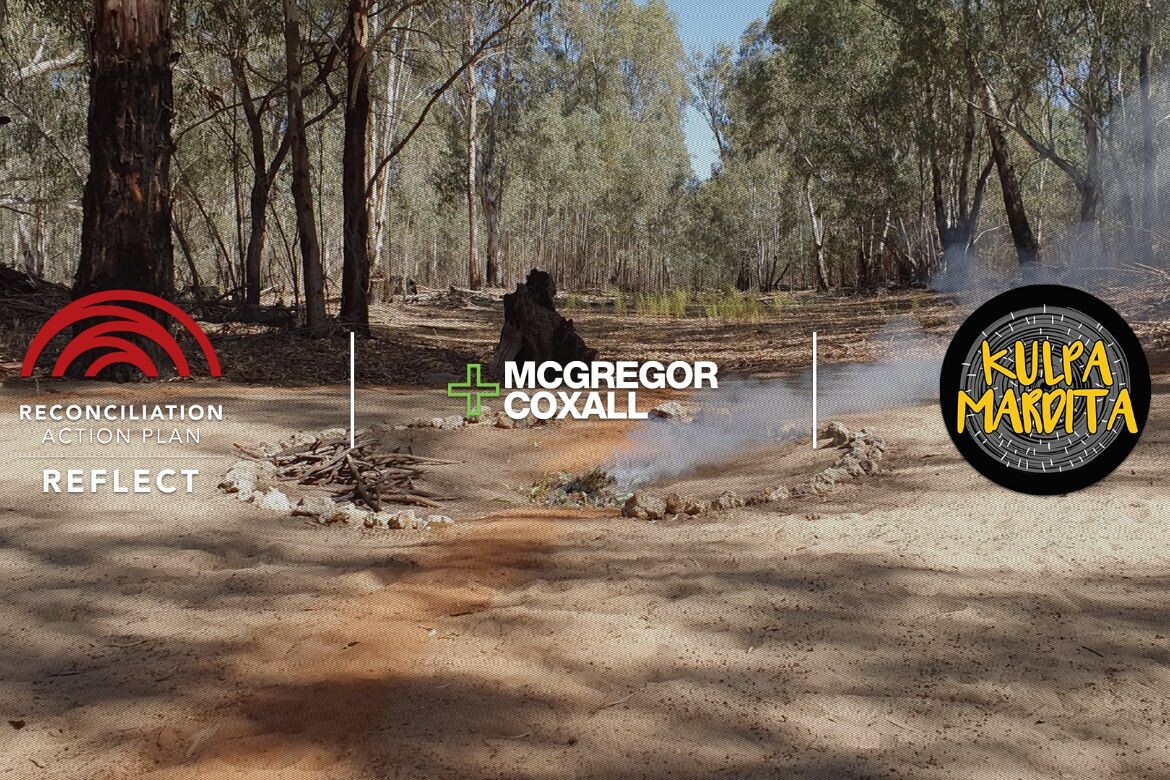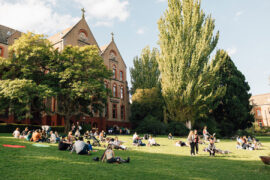Landscape architecture is enjoying a rise in prominence. Today, it’s taking a seat at the design table from the very beginning of a project, so we bring you some of the leading practices.

Hassett Park, Jane Irwin Landscape Architecture, photograph by Dianna Snape.
November 9th, 2023
The landscape that surrounds our buildings, whether public or private, has always been vital to a fully realised project. However, these days it seems that the landscape and the profession of landscape architecture is achieving accolades and the recognition that it has always deserved but not always received. Whether it’s a garden that surrounds a home, re-imagining a park or vegetating a large public space, the landscape we inhabit makes our lives better and every project complete.
These days, planting with Country, using local species and understanding changing weather systems are imperative to best practice. Drought-tolerant plants for a dry Australian environment should be a given, and this practice is now front and centre for landscape architects and designers, especially for large public projects. Of course, First Nations people have understood this for millennia – it’s just taken the rest of us time to catch up.
We speak to some leading practitioners in landscape architecture and design today and see how the profession has changed, where it is now and how their contribution is supporting best design.
Jane Irwin Landscape Design
Jane Irwin landscape Design is renowned for its sensitive and beautifully conceived landscape projects. Large and small projects, residential through to urban precincts and everything in between, this practice works its magic on a diverse range of eclectic projects and has done so for some 27 years. Principal, Jane Irwin, reflects on her practice and the industry she loves: “We need to be involved from the planning stages, because landscape architecture starts with knowledge of the place that can contribute to the way the whole site is planned. We really start to look at things from the site, from its ancient history and its natural systems and all sorts of angles that actually make up the site.”
Of changes in the industry, Irwin adds: “When I started a long time ago there was a tendency to just leave some spaces for landscape when the main architecture was finished. But I think landscape architects have found their feet – they know what they can do themselves as design leaders and within a design team now.”


A project of note that the practice is undertaking at the moment is Shakespeare Place in Sydney, part of the Macquarie Street East Precinct project and the way of working is changing.
“This project is being driven by the client, Property and Development New South Wales. They have a landscape architect as head of design and they’re approaching it from a completely different angle and actually looking at it through pre-colonial eyes. They are approaching it through a First Nations understanding or presence in the place and that’s a very different community consultation as we really need to be working with experts in that field. Working with First Nations People can provide a bridge between Elders and communities, and having their design input means that we can specifically imbue the place with that very fundamental idea of Country. It is really a big change in the way of working,” says Irwin.

Finally, Irwin sees not only the landscape architecture profession changing but Australia’s attitude more broadly. “I think that architectural and landscape architecture practices are going through a moment. And that moment is really going back to where it should always start from, which is knowing where you are on Country and responding through different eyes, other than colonial eyes. So, we’re going through a period of decolonisation.”
Mala Landscape Architecture and urban Design
For Campbell Morris, managing director at Mala Landscape Architecture and Urban Design (Mala), there are a multitude of projects at hand. While the practice has completed large projects such as Alba Thermal Springs and Spa on Victoria’s Mornington Peninsula in collaboration with Hayball, the practice always creates site and client specific design.
Morris has been in the business for some years and cut his landscape teeth on large projects working with TCL. He established his own practice in 2014 and in 2019 was joined by Bob Barton as co-director and together they have studios in Melbourne and Sorrento in Victoria as well as Fremantle, Western Australia.


There have been changes over the years as Morris comments: “Some 15 years ago, projects were always led by architects and now there are more and more being led by landscape architects, which they certainly should be when they are site-wide projects. We’re now involved in projects where we are actually engaged before the architect, to start planning and provide strategies and master planning and to actually site and locate buildings and structures. And then we prepare a list of recommended preferred architects to the client to engage from that point.”
The studio works across a variety of scales and types of projects that include, tourism, hospitality, in the public realm with parks and recreation, residential and commercial, rooftop and vertical gardens through to education and health, bridges, freeways and infrastructure.


With such a variety of projects completed and in progress, one commission of note is the Geelong Grammar masterplan that includes a multitude of local flora, species endemic to the area. “We look at those plants that have evolved over millions of years to survive in the particular conditions. They worked then and are best now.”
Mala is thriving and delivering outstanding projects to its clients and Morris loves his job saying, “We get to work with incredible collaborators, just within our studio itself, we have architects, industrial designers, people who have backgrounds in fashion, not just in landscape architecture and horticulture. So, we come from all walks of life. We get to work on an incredibly, diverse portfolio and that keeps me really interested in the profession.”

Warren and Mahoney
Over the past 12 months, Warren and Mahoney has formed a specialised Urban Design and Landscape Architecture team, bringing together leading experts from New Zealand/Aotearoa and Australia.
This is a natural extension for the studio that has designed city-shaping buildings, precincts and landscapes since its inception, including Auckland’s Wynyard Quarter and Melbourne’s North East Link Project – Winner of the 2022 World Architecture Festival WAFX Future Project: Infrastructure Award.
Led by urban designer and Principal, Thomas Hale and landscape architect Michael Hawes, the team brings together landscape architecture and urban design specialists across seven Australasian studios. The specialisation enables Warren and Mahoney to offer a completely integrated design solution incorporating architecture, Indigenous consultation, sustainability and digital design.


“As an urban design and landscape architecture team, we operate at the intersection of economics, politics and the natural environment. And while that space can be full of tension, it’s a rich environment for design to solve strategic problems that have far-reaching impact. It’s been fantastic to see the market respond so positively to our offer,” says Hale.
Recently, the team has been active on projects including the Maritime Museum and downtown precincts in Auckland. It is also overseeing the heritage redevelopment of the Pyrmont Campus in Sydney for Google. This complex development required a sensitive urban design strategy, stitching together a high-profile water’s edge and reconnecting the area to the bay.

“Whether it’s the district, precinct or at city scale, we appreciate that the landscape is often at the convergence of many interests,” adds Hawes. “Collaboration, respect and creative expression can unlock opportunities and a deeper understanding of the qualities of a place. The projects we are being engaged in are increasingly complex and, as landscape architects and urban designers, we must be able to navigate, innovate and ultimately be integrators across a broad range of considerations – with a keen focus on the challenges of climate change, biodiversity loss, cultural identity, and the social and economic vibrancy that our communities face.”
DKO
DKO has also recently established a landscape architecture team to add to its practice offering. Providing landscape design ensures a complete package for clients and with a multi-disciplinary, 250-strong team across the Asia-Pacific region, this is a new and welcome addition.
Two passionate practitioners, Sam McCubbin and Daisy Richmond-Smith, head up the landscape architecture team and, with just several months since establishment of the studio under their belts, there is already a large and diverse portfolio of projects on the drawing board.

For McCubbin and Richmond-Smith, the work is about blurring the distinction between architecture and landscape, enhancing the interplay of the built form and nature while taking a culturally sensitive and ecological approach to each project.
There is passion in their approach and collaboration is key to their ideas about landscape as Richmond-Smith explains: “I know personally the joy that gardens, landscapes and outdoor green spaces can bring. And so, I want to bring that to as many people as possible and to create evocative natural environments and to strengthen people’s connection with nature. I feel that’s really important. I think it changes the way that people think about the natural world, if they are in close connection with nature.”


With residential, community and large masterplan projects in the mix, McCubbin and Richmond-Smith are agile and adaptable as McCubbin comments: “I really just want to improve the projects that we’re doing through this more holistic design approach that includes landscape.”
“Something that Sam and I have in common is that we really want to create people-centred design. At the heart of this is that we want to create these beautiful seamless journeys for people,” says Richmond-Smith.
McGregor Coxall
McGregor Coxall was founded in 1998 by Adrian McGregor and Phil Coxall. What began as a boutique landscape architecture studio in Manly, Sydney with a team of 30, is now a world player with 110-plus staff spanning four disciplines and six locations in Australia and the United Kingdom.
McGregor Coxall’s offerings are landscape architecture, urban design, engineerin, and biourbanism – city intelligence, research and development (digital twins, data mapping, computational design), and projects encompass the public realm from hospitals to residential development, tourism, transport, water security and beyond.


Designing with Country is integral to McGregor Coxall and begins on day one of a project where its studios across Australia are committed to engaging with reconciliation and Aboriginal and Torres Strait Islander people. Its Reflect Reconciliation Action Plan (RAP) has been endorsed by Reconciliation Australia and, continuing its commitment, a three-year design research partnership between McGregor Coxall and RMIT’s Yulendj Weelam Design Research Lab from the School of Architecture and Urban Design has been instigated.
In all its projects McGregor Coxall selects materials, plants, and design elements that reflect the character of the site to create outcomes that both protect remnant vegetation and enhance biodiversity.
A project of note is the recently completed Art Gallery of New South Wales, $344 million Sydney Modern Project. The commission was delivered by Infrastructure NSW on behalf of the NSW Government and AGNSW. McGregor Coxall provided landscape architecture services for the public domain and art gardens, in collaboration with SANAA, the Art Gallery of New South Wales, Architectus, Arup and Richard Crookes Constructions.


Commenting on the changing role of landscape architects, Nadia Greatbatch, associate director and landscape architecture discipline lead at McGregor Coxall, says, “Landscape architecture is ostensibly in demand as lead consultant where largely we weren’t some years ago. Now leading multi-disciplinary project teams and driving larger conversation, landscape architecture is seen as integral to the journey of a project from beginning to end.”
From small to large landscape architecture practices, and upon reading the comments above, it is clear to see that there is a change of perspective from architects to the general public in the work undertaken by landscape architects.
Whether the project provides a place of respite for the public, landscaped surrounds for a commercial commission or a beautiful residential garden, the work of the landscape architect is receiving the recognition if has always deserved. As health, wellbeing and wellness are now a priority for everyone, it is heartening to know that landscape architects are at the forefront of an awakening that nature can enhance every project and help us achieve a better way of living.
Jila
jila.net.au
Mala
mala.net.au
Warren and Mahoney
warrenandmahoney.com
DKO
dko.com.au
McGregor Coxall
mcgregorcoxall.com
Photography
Various
We think you might also like this story on Parramatta Aquatic Centre featuring Coral McGregor.
INDESIGN is on instagram
Follow @indesignlive
A searchable and comprehensive guide for specifying leading products and their suppliers
Keep up to date with the latest and greatest from our industry BFF's!

A curated exhibition in Frederiksstaden captures the spirit of Australian design

For Aidan Mawhinney, the secret ingredient to Living Edge’s success “comes down to people, product and place.” As the brand celebrates a significant 25-year milestone, it’s that commitment to authentic, sustainable design – and the people behind it all – that continues to anchor its legacy.

Pier Pavilion by Besley & Spresser provides a refreshing, architecturally thoughtful and versatile public space by the water at Barangaroo.

With Steelcase having reopened its refreshed WorkLife Showroom in Singapore this year, we spoke to Navedita Shergill about some key workplace macro shifts identified in their research.
The internet never sleeps! Here's the stuff you might have missed

CPD Live returns for its final live-presented season of 2025, bringing architects, designers, and specifiers a free opportunity to earn CPD points before the year ends. Kicking off at 9 AM AEDT, This Tuesday 14th October.

Opening in October 2025, The Standard, Pattaya Na Jomtien brings together ONION, DIN Studio, Studio Lupine and Verena Haller to create a sculptural modernist retreat where art, architecture and coastal culture meet.

Abbotsford Convent has appointed Kennedy Nolan to guide the next stage of development at the heritage-listed Melbourne precinct, continuing its evolution as a cultural and community landmark.